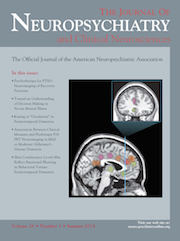Psychotic Episode in a Patient With Alzheimer’s Dementia While Shifting From the Oral to Patch Form of Rivastigmine
To the Editor: The transdermal rivastigmine patch is widely used as a cognitive enhancer in Alzheimer’s-type dementia. There are very few reports on the neuropsychiatric symptoms precipitated by the rivastigmine patch. Presented here is a case of a psychotic episode that is precipitated by use of the rivastigmine patch and the experience of a rechallenge with oral rivastigmine. The possible pharmacodynamic and pharmacokinetic mechanisms are discussed.
Case Report
A 78-year-old married man, accompanied by his wife and daughter, visited the outpatient clinic of the Department of Psychiatry for symptoms of gradual cognitive decline and mildly impaired daily life ability for nearly 1 year. He had no prior medical or psychiatric history. Blood chemistry, comprehensive blood count, vitamin B12 level, folic acid level, the rapid plasma reagin test, and thyroid function were unremarkable. Brain CT scans showed mild cortical atrophy. His Mini-Mental State Exam was 16/30 and Clinical Dementia Rating Scale was 1.0. Thus, he was diagnosed with Alzheimer’s-type dementia.
The patient was treated with oral rivastigmine 1.5 mg twice a day that was titrated after 2 weeks to 3 mg twice a day. After 4 weeks, oral rivastigmine was changed to the rivastigmine patch 5 mg/cm2 for 24 hours for the patient's convenience. However, within 3 days of the change, he developed a psychotic episode with visual hallucinations and delusional thoughts such as “somebody is intruding in my house to kill me.” His family discontinued the patch, and his psychotic symptoms subsided without any antipsychotic treatment approximately 2 days later.
Because his wife and daughter were concerned about his cognitive decline, the patient was rechallenged with oral rivastigmine 3.0 mg twice a day after adequate discussion with them. In the 8 weeks of follow-up and 4 weeks of oral rivastigmine, no more psychotic episodes were reported.
Discussion
A psychotic episode occurred after rivastigmine was shifted from oral to patch form and did not recur after the patch form was discontinued. No psychotic episode was noted even after rechallenge with oral rivastigmine. Thus, the temporal relationship strongly suggests that the psychotic episode was precipitated by the patch form of rivastigmine.
There have been several reports on rivastigmine-associated neuropsychiatric side effects, including manic episode with the oral form1 and extrapyramidal syndrome with the patch form.2 There is a record of psychotic symptoms as an adverse drug reaction on the web database, but no case report on a psychotic episode related to rivastigmine use has been published.3 To date, this is the first report of a psychotic episode precipitated by the patch form of rivastigmine.
On the basis of the findings on the irreversible acetylcholinesterase inhibitory effects of organophosphate pesticides, hypercholinergic activity can precipitate psychotic and other neuropsychiatric symptoms.4 A pharmacokinetic study showed that there is no difference in blood levels between Asians and whites using the rivastigmine patch,5 but individual differences in skin permeability among elderly persons may explain the possible “dumping” of transdermal release of drugs, which can precipitate a psychotic episode.
With careful monitoring, the shift back to the oral form should also be tried to provide the opportunity of cognitive enhancement by treatment with effective medication.
1 : A rivastigmine-precipitated manic episode in a patient with Alzheimer-type dementia. Int Psychogeriatr 2012; 24:1697–1699Crossref, Medline, Google Scholar
2 : Acute dystonic reaction with rivastigmine. Int Psychogeriatr 2013; 25:1385–1386Crossref, Medline, Google Scholar
3
4 : Organophosphate-induced brain damage: mechanisms, neuropsychiatric and neurological consequences, and potential therapeutic strategies. Neurotoxicology 2012; 33:391–400Crossref, Medline, Google Scholar
5 : Pharmacokinetics of a novel transdermal rivastigmine patch for the treatment of Alzheimer’s disease: a review. Int J Clin Pract 2009; 63:799–805Crossref, Medline, Google Scholar



